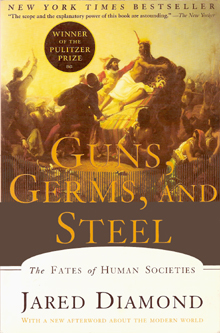ISBN 9780393317558
La enciclopedia de ciencias y tecnologías en Argentina
Diamond, Jared; Guns, germs, and steel: the fates of human societies; Norton & Company; Londres - Nueva York; 1997; ISBN 9780393317558 (Diamond GGS)
Contenido
Contenido
Se discute la evolución de la humanidad y los factores que influyeron en ella, así como las probables razones por las que algunos pueblos construyeron culturas más basadas en las tecnologías que otros. Desde un punto de vista predominantemente biológico, Diamond cuestiona la excluyente visión occidental del progreso humano aportando a la comprensión de los factores naturales (geográficos y ecológicos) que condicionan las diversidades culturales. El tratamiento abarca temas como la domesticación prehistórica de plantas y animales, la influencia de las enfermedades, el surgimiento de la escritura y de algunas tecnologías críticas en partes tan variadas del mundo como el "creciente fértil" del Cercano Oriente, China, Mesoamérica y el sureste de los actuales EEUU.
Índice
- Preface to the paperback edition (Why is world history like an onion?). 9‑11.
- Prologue. Yali's question (The regionally differing courses of history). 13‑32.
- Part one. From Eden to Cajamarca. 33‑81.
- Chapter 1. Up to the starting line (What happened on all the continente before 11,000 B.C.?). 35‑52.
- Chapter 2. A natural experiment of history (How geography molded societies on polynesian islands). 53‑66.
- Chapter 3. Collision at Cajamarca (Why the inca emperor Atahuallpa did not capture king Charles I of Spain). 67‑81.
- Part two. The rise and spread of food production. 83‑191.
- Chapter 4. Farmer power (The roots of guns, germs, and steel). 85‑92.
- Chapter 5. History's haves and have-nots (Geographic differences in the onset of food production). 93‑103.
- 16 páginas de fotografías en gama de grises. Entre páginas 96 y 97.
- Chapter 6. To farm or not to farm (Causes of the spread of food production). 104‑113.
- Chapter 7. How to make an almond (The unconscious development of ancient crops). 114‑130.
- Chapter 8. Apples or indians (Why did peoples of some regions fail to domesticate plants?). 131‑156.
- Chapter 9. Zebras, unhappy marriages, and the Anna Karenina Principle (Why were most big wild mammal species never domesticated?). 157‑175.
- Chapter 10. Spacious skies and tilted axes (Why did food production spread at different rates on different continents?). 176‑191.
- Part three. From food to guns, germs, and steel. 193‑292.
- Chapter 11. Lethal gift of livestock (The evolution of germs). 195‑214.
- Chapter 12. Blueprints and borrowed letters (The evolution of writing). 215‑238.
- Chapter 13. Necessity's mother (The evolution of technology). 239‑264.
- Chapter 14. From egalitarianism to kleptocracy (The evolution of government and religion). 265‑292.
- 16 páginas de fotografías en gama de grises. Entre páginas 288 y 289.
- Part four. Around the world in five chapters. 292‑401.
- Chapter 15. Yali's people (The histories of australia and new guinea). 293‑321.
- Chapter 16. How China became chinese (The history of east asia). 322‑333.
- Chapter 17. Speedboat to Polynesia (The history of the austronesian expansion). 334‑353.
- Chapter 18. Hemispheres colliding. (The histories of Eurasia and the Americas compared). 354‑375.
- Chapter 19. How africa became black (The history of Africa). 376‑401.
- Epilogue. 403‑440.
- The future of human history as a science. 405‑425
- 2003 afterword: guns, germs, and steel today. 426‑440.
- Acknowledgments. 441.
- Further readings. 442‑471.
- Credits. 472‑473.
- Index. 475‑494.
- Discussion questions. 495‑496.
Otras ediciones
- Diamond, Jared; Armas, gérmenes y acero; Editorial Debate (Random House Mondadori; España y otros países; ISBN 8483061201/848306667/8483463261.
Transclusión
El texto que se lee cuando se transcluye esta página es:
- Diamond, Jared; Guns, germs, and steel: the fates of human societies; Norton & Company; Londres - Nueva York; 1997; ISBN 9780393317558 (Diamond GGS)
